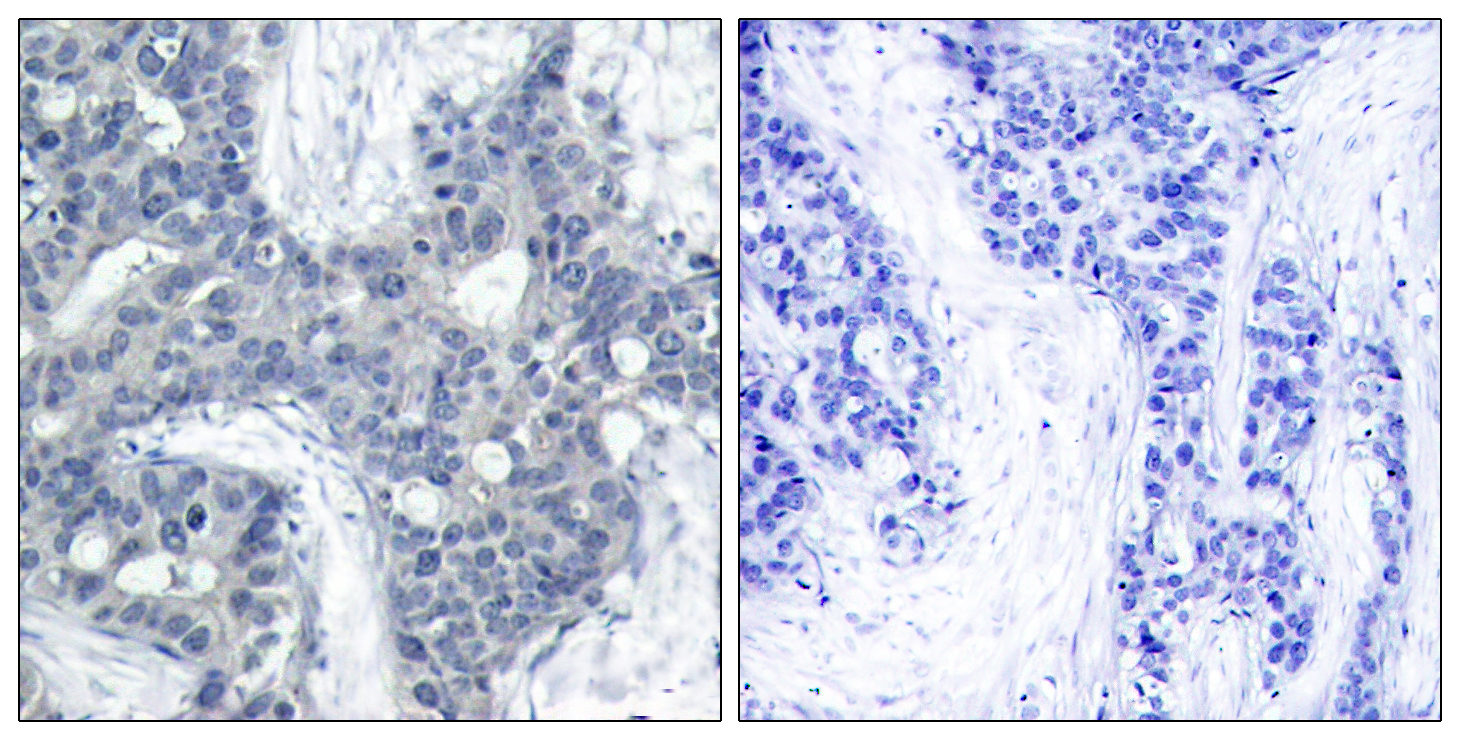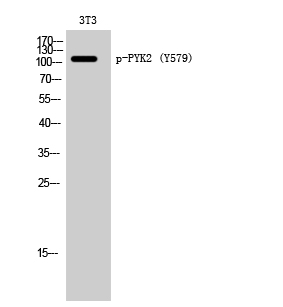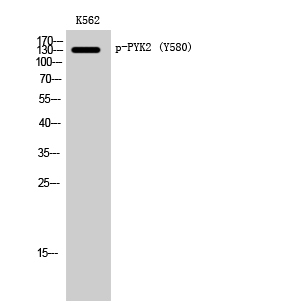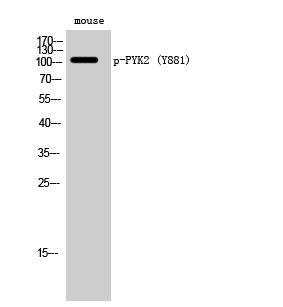
Catalog: YP0609
Size
Price
Status
Qty.
200μL
$600.00
In stock
0
100μL
$340.00
In stock
0
50μL
$190.00
In stock
0
Add to cart


Collected


Collect
Main Information
Target
PYK2
Host Species
Rabbit
Reactivity
Human, Mouse, Rat
Applications
WB, IHC, IF, ELISA
MW
116kD (Observed)
Conjugate/Modification
Phospho
Detailed Information
Recommended Dilution Ratio
WB 1:500-1:2000; IHC 1:100-1:300; ELISA 1:5000; IF 1:50-200
Formulation
Liquid in PBS containing 50% glycerol, 0.5% BSA and 0.02% sodium azide.
Specificity
Phospho-PYK2 (Y881) Polyclonal Antibody detects endogenous levels of PYK2 protein only when phosphorylated at Y881.The name of modified sites may be influenced by many factors, such as species (the modified site was not originally found in human samples) and the change of protein sequence (the previous protein sequence is incomplete, and the protein sequence may be prolonged with the development of protein sequencing technology). When naming, we will use the "numbers" in historical reference to keep the sites consistent with the reports. The antibody binds to the following modification sequence (lowercase letters are modification sites):LVyLN
Purification
The antibody was affinity-purified from rabbit antiserum by affinity-chromatography using epitope-specific immunogen.
Storage
-15°C to -25°C/1 year(Do not lower than -25°C)
Concentration
1 mg/ml
MW(Observed)
116kD
Modification
Phospho
Clonality
Polyclonal
Isotype
IgG
Related Products
Antigen&Target Information
Immunogen:
The antiserum was produced against synthesized peptide derived from human PYK2 around the phosphorylation site of Tyr881. AA range:847-896
show all
Specificity:
Phospho-PYK2 (Y881) Polyclonal Antibody detects endogenous levels of PYK2 protein only when phosphorylated at Y881.The name of modified sites may be influenced by many factors, such as species (the modified site was not originally found in human samples) and the change of protein sequence (the previous protein sequence is incomplete, and the protein sequence may be prolonged with the development of protein sequencing technology). When naming, we will use the "numbers" in historical reference to keep the sites consistent with the reports. The antibody binds to the following modification sequence (lowercase letters are modification sites):LVyLN
show all
Gene Name:
PTK2B
show all
Protein Name:
Protein-tyrosine kinase 2-beta
show all
Other Name:
PTK2B ;
FAK2 ;
PYK2 ;
RAFTK ;
Protein-tyrosine kinase 2-beta ;
Calcium-dependent tyrosine kinase ;
CADTK ;
Calcium-regulated non-receptor proline-rich tyrosine kinase ;
Cell adhesion kinase beta ;
CAK-beta ;
CAKB ;
Focal adhesion kinase 2 ;
FADK 2 ;
Pro
FAK2 ;
PYK2 ;
RAFTK ;
Protein-tyrosine kinase 2-beta ;
Calcium-dependent tyrosine kinase ;
CADTK ;
Calcium-regulated non-receptor proline-rich tyrosine kinase ;
Cell adhesion kinase beta ;
CAK-beta ;
CAKB ;
Focal adhesion kinase 2 ;
FADK 2 ;
Pro
show all
Database Link:
Background:
This gene encodes a cytoplasmic protein tyrosine kinase which is involved in calcium-induced regulation of ion channels and activation of the map kinase signaling pathway. The encoded protein may represent an important signaling intermediate between neuropeptide-activated receptors or neurotransmitters that increase calcium flux and the downstream signals that regulate neuronal activity. The encoded protein undergoes rapid tyrosine phosphorylation and activation in response to increases in the intracellular calcium concentration, nicotinic acetylcholine receptor activation, membrane depolarization, or protein kinase C activation. This protein has been shown to bind CRK-associated substrate, nephrocystin, GTPase regulator associated with FAK, and the SH2 domain of GRB2. The encoded protein is a member of the FAK subfamily of protein tyrosine kinases but lacks significant sequence similarity t
show all
Function:
Catalytic activity:ATP + a [protein]-L-tyrosine = ADP + a [protein]-L-tyrosine phosphate.,Function:Involved in calcium induced regulation of ion channel and activation of the map kinase signaling pathway. May represent an important signaling intermediate between neuropeptide activated receptors or neurotransmitters that increase calcium flux and the downstream signals that regulate neuronal activity. Interacts with the SH2 domain of Grb2. May phosphorylate the voltage-gated potassium channel protein Kv1.2. Its activation is highly correlated with the stimulation of c-Jun N-terminal kinase activity. Involved in osmotic stress-dependent SNCA 'Tyr-125' phosphorylation.,PTM:Phosphorylated on tyrosine residues in response to various stimuli that elevate the intracellular calcium concentration, as well as by PKC activation. Recruitment by nephrocystin to cell matrix adhesions initiates Tyr-402 phosphorylation. In monocytes, adherence to substrata is required for tyrosine phosphorylation and kinase activation. Angiotensin II, thapsigargin and L-alpha-lysophosphatidic acid (LPA) also induce autophosphorylation and increase kinase activity.,similarity:Belongs to the protein kinase superfamily. Tyr protein kinase family.,similarity:Belongs to the protein kinase superfamily. Tyr protein kinase family. FAK subfamily.,similarity:Contains 1 FERM domain.,similarity:Contains 1 protein kinase domain.,subcellular location:Interaction with nephrocystin induces the membrane-association of the kinase.,subunit:Interacts with Crk-associated substrate (Cas), PTPNS1 and SH2D3C (By similarity). Interacts with nephrocystin, ASAP2, OPHN1L, SKAP2 and TGFB1I1.,tissue specificity:Most abundant in the brain, with highest levels in amygdala and hippocampus. Low levels in kidney. Also expressed in spleen and lymphocytes.,
show all
Cellular Localization:
Cytoplasm. Cytoplasm, perinuclear region. Cell membrane; Peripheral membrane protein; Cytoplasmic side. Cell junction, focal adhesion. Cell projection, lamellipodium. Cytoplasm, cell cortex. Nucleus. Interaction with NPHP1 induces the membrane-association of the kinase. Colocalizes with integrins at the cell periphery.
show all
Tissue Expression:
Most abundant in the brain, with highest levels in amygdala and hippocampus. Low levels in kidney (at protein level). Also expressed in spleen and lymphocytes.
show all
Research Areas:
>>Calcium signaling pathway ;
>>Chemokine signaling pathway ;
>>Phospholipase D signaling pathway ;
>>Natural killer cell mediated cytotoxicity ;
>>Leukocyte transendothelial migration ;
>>GnRH signaling pathway ;
>>Yersinia infection ;
>>Hepatitis B ;
>>Human cytomegalovirus infection ;
>>Human immunodeficiency virus 1 infection
>>Chemokine signaling pathway ;
>>Phospholipase D signaling pathway ;
>>Natural killer cell mediated cytotoxicity ;
>>Leukocyte transendothelial migration ;
>>GnRH signaling pathway ;
>>Yersinia infection ;
>>Hepatitis B ;
>>Human cytomegalovirus infection ;
>>Human immunodeficiency virus 1 infection
show all
Signaling Pathway
Organismal Systems >> Immune system >> Natural killer cell mediated cytotoxicity
Organismal Systems >> Immune system >> Leukocyte transendothelial migration
Organismal Systems >> Immune system >> Chemokine signaling pathway
Organismal Systems >> Endocrine system >> GnRH signaling pathway
Environmental Information Processing >> Signal transduction >> Calcium signaling pathway
Environmental Information Processing >> Signal transduction >> Phospholipase D signaling pathway
Reference Citation({{totalcount}})
Catalog: YP0609
Size
Price
Status
Qty.
200μL
$600.00
In stock
0
100μL
$340.00
In stock
0
50μL
$190.00
In stock
0
Add to cart


Collected


Collect
Recently Viewed Products
Clear allPRODUCTS
CUSTOMIZED
ABOUT US
Toggle night Mode
{{pinfoXq.title || ''}}
Catalog: {{pinfoXq.catalog || ''}}
Filter:
All
{{item.name}}
{{pinfo.title}}
-{{pinfo.catalog}}
Main Information
Target
{{pinfo.target}}
Reactivity
{{pinfo.react}}
Applications
{{pinfo.applicat}}
Conjugate/Modification
{{pinfo.coupling}}/{{pinfo.modific}}
MW (kDa)
{{pinfo.mwcalc}}
Host Species
{{pinfo.hostspec}}
Isotype
{{pinfo.isotype}}
Product {{index}}/{{pcount}}
Prev
Next
{{pvTitle}}
Scroll wheel zooms the picture
{{pvDescr}}




















